2007 CHEVROLET EQUINOX change time
[x] Cancel search: change timePage 367 of 492
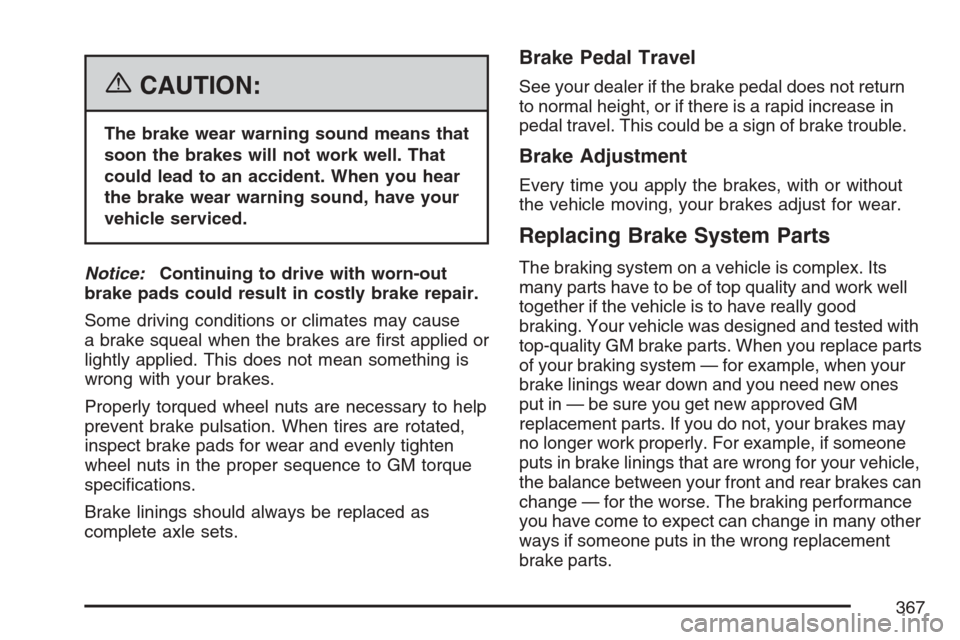
{CAUTION:
The brake wear warning sound means that
soon the brakes will not work well. That
could lead to an accident. When you hear
the brake wear warning sound, have your
vehicle serviced.
Notice:Continuing to drive with worn-out
brake pads could result in costly brake repair.
Some driving conditions or climates may cause
a brake squeal when the brakes are �rst applied or
lightly applied. This does not mean something is
wrong with your brakes.
Properly torqued wheel nuts are necessary to help
prevent brake pulsation. When tires are rotated,
inspect brake pads for wear and evenly tighten
wheel nuts in the proper sequence to GM torque
speci�cations.
Brake linings should always be replaced as
complete axle sets.
Brake Pedal Travel
See your dealer if the brake pedal does not return
to normal height, or if there is a rapid increase in
pedal travel. This could be a sign of brake trouble.
Brake Adjustment
Every time you apply the brakes, with or without
the vehicle moving, your brakes adjust for wear.
Replacing Brake System Parts
The braking system on a vehicle is complex. Its
many parts have to be of top quality and work well
together if the vehicle is to have really good
braking. Your vehicle was designed and tested with
top-quality GM brake parts. When you replace parts
of your braking system — for example, when your
brake linings wear down and you need new ones
put in — be sure you get new approved GM
replacement parts. If you do not, your brakes may
no longer work properly. For example, if someone
puts in brake linings that are wrong for your vehicle,
the balance between your front and rear brakes can
change — for the worse. The braking performance
you have come to expect can change in many other
ways if someone puts in the wrong replacement
brake parts.
367
Page 397 of 492
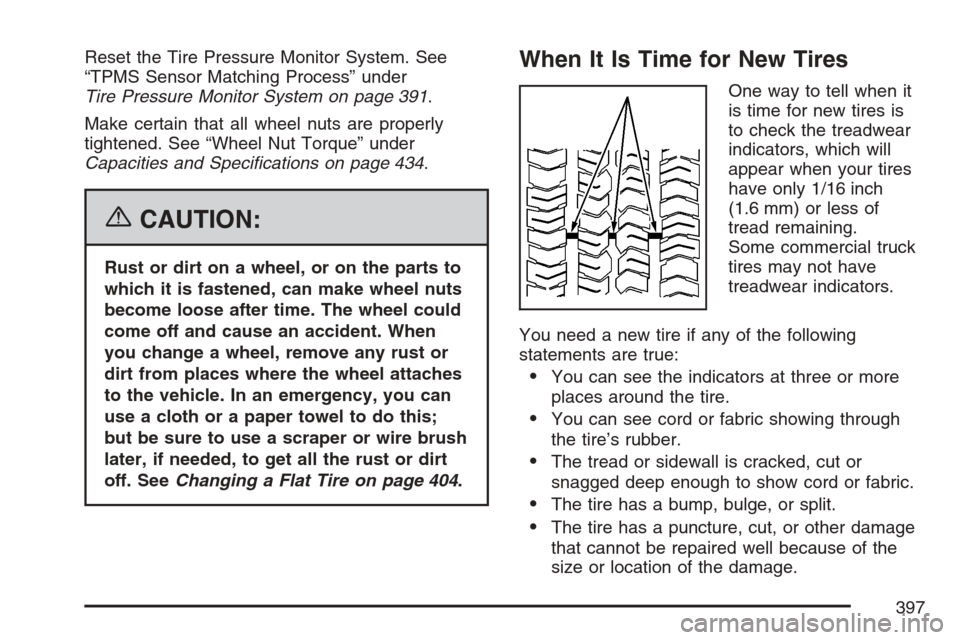
Reset the Tire Pressure Monitor System. See
“TPMS Sensor Matching Process” under
Tire Pressure Monitor System on page 391.
Make certain that all wheel nuts are properly
tightened. See “Wheel Nut Torque” under
Capacities and Speci�cations on page 434.
{CAUTION:
Rust or dirt on a wheel, or on the parts to
which it is fastened, can make wheel nuts
become loose after time. The wheel could
come off and cause an accident. When
you change a wheel, remove any rust or
dirt from places where the wheel attaches
to the vehicle. In an emergency, you can
use a cloth or a paper towel to do this;
but be sure to use a scraper or wire brush
later, if needed, to get all the rust or dirt
off. SeeChanging a Flat Tire on page 404.
When It Is Time for New Tires
One way to tell when it
is time for new tires is
to check the treadwear
indicators, which will
appear when your tires
have only 1/16 inch
(1.6 mm) or less of
tread remaining.
Some commercial truck
tires may not have
treadwear indicators.
You need a new tire if any of the following
statements are true:
You can see the indicators at three or more
places around the tire.
You can see cord or fabric showing through
the tire’s rubber.
The tread or sidewall is cracked, cut or
snagged deep enough to show cord or fabric.
The tire has a bump, bulge, or split.
The tire has a puncture, cut, or other damage
that cannot be repaired well because of the
size or location of the damage.
397
Page 411 of 492
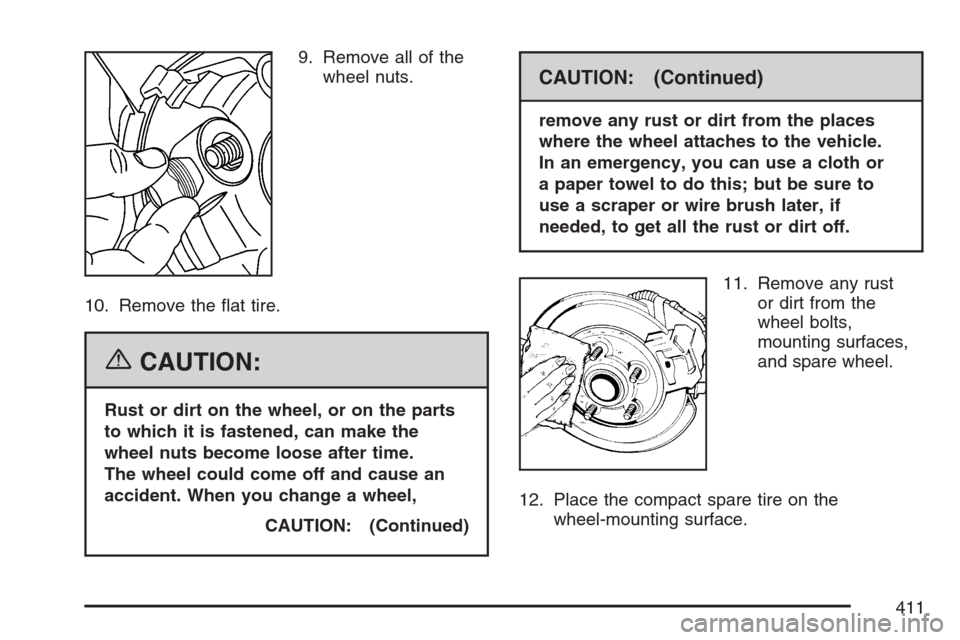
9. Remove all of the
wheel nuts.
10. Remove the �at tire.
{CAUTION:
Rust or dirt on the wheel, or on the parts
to which it is fastened, can make the
wheel nuts become loose after time.
The wheel could come off and cause an
accident. When you change a wheel,
CAUTION: (Continued)
CAUTION: (Continued)
remove any rust or dirt from the places
where the wheel attaches to the vehicle.
In an emergency, you can use a cloth or
a paper towel to do this; but be sure to
use a scraper or wire brush later, if
needed, to get all the rust or dirt off.
11. Remove any rust
or dirt from the
wheel bolts,
mounting surfaces,
and spare wheel.
12. Place the compact spare tire on the
wheel-mounting surface.
411
Page 439 of 492
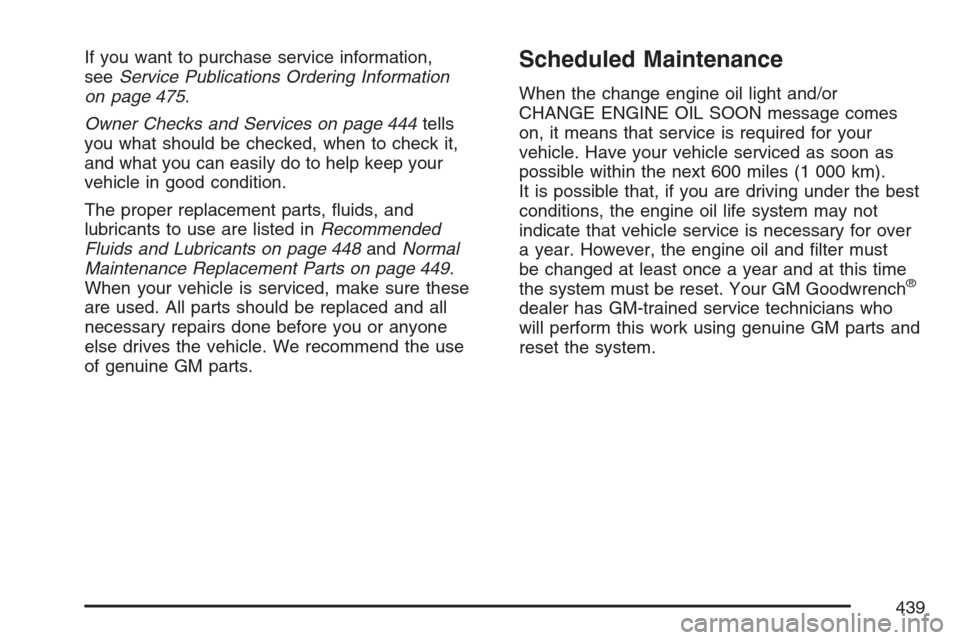
If you want to purchase service information,
seeService Publications Ordering Information
on page 475.
Owner Checks and Services on page 444tells
you what should be checked, when to check it,
and what you can easily do to help keep your
vehicle in good condition.
The proper replacement parts, �uids, and
lubricants to use are listed inRecommended
Fluids and Lubricants on page 448andNormal
Maintenance Replacement Parts on page 449.
When your vehicle is serviced, make sure these
are used. All parts should be replaced and all
necessary repairs done before you or anyone
else drives the vehicle. We recommend the use
of genuine GM parts.Scheduled Maintenance
When the change engine oil light and/or
CHANGE ENGINE OIL SOON message comes
on, it means that service is required for your
vehicle. Have your vehicle serviced as soon as
possible within the next 600 miles (1 000 km).
It is possible that, if you are driving under the best
conditions, the engine oil life system may not
indicate that vehicle service is necessary for over
a year. However, the engine oil and �lter must
be changed at least once a year and at this time
the system must be reset. Your GM Goodwrench
®
dealer has GM-trained service technicians who
will perform this work using genuine GM parts and
reset the system.
439
Page 465 of 492
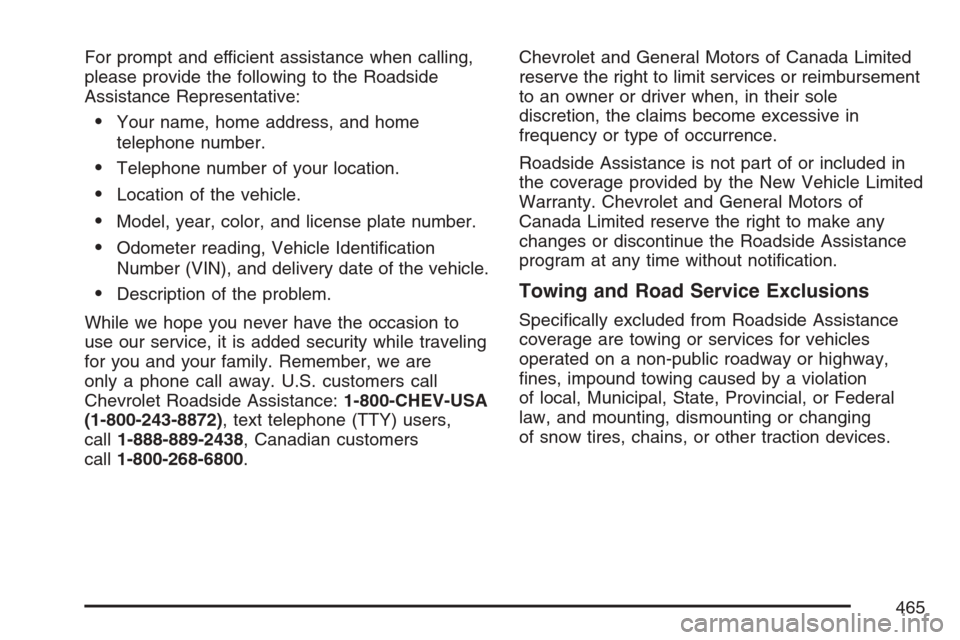
For prompt and efficient assistance when calling,
please provide the following to the Roadside
Assistance Representative:
Your name, home address, and home
telephone number.
Telephone number of your location.
Location of the vehicle.
Model, year, color, and license plate number.
Odometer reading, Vehicle Identi�cation
Number (VIN), and delivery date of the vehicle.
Description of the problem.
While we hope you never have the occasion to
use our service, it is added security while traveling
for you and your family. Remember, we are
only a phone call away. U.S. customers call
Chevrolet Roadside Assistance:1-800-CHEV-USA
(1-800-243-8872), text telephone (TTY) users,
call1-888-889-2438, Canadian customers
call1-800-268-6800.Chevrolet and General Motors of Canada Limited
reserve the right to limit services or reimbursement
to an owner or driver when, in their sole
discretion, the claims become excessive in
frequency or type of occurrence.
Roadside Assistance is not part of or included in
the coverage provided by the New Vehicle Limited
Warranty. Chevrolet and General Motors of
Canada Limited reserve the right to make any
changes or discontinue the Roadside Assistance
program at any time without noti�cation.Towing and Road Service Exclusions
Speci�cally excluded from Roadside Assistance
coverage are towing or services for vehicles
operated on a non-public roadway or highway,
�nes, impound towing caused by a violation
of local, Municipal, State, Provincial, or Federal
law, and mounting, dismounting or changing
of snow tires, chains, or other traction devices.
465
Page 468 of 492
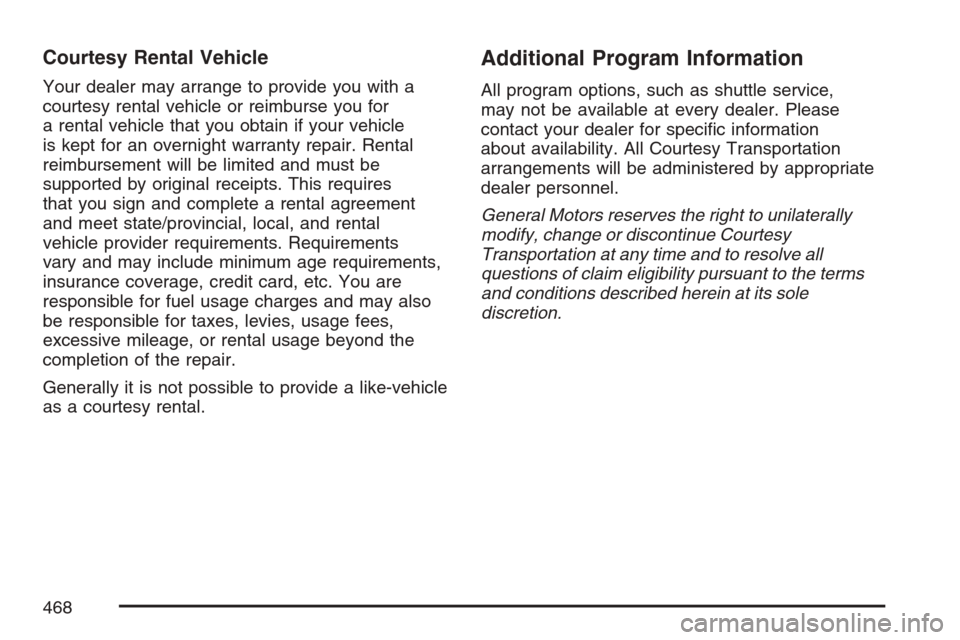
Courtesy Rental Vehicle
Your dealer may arrange to provide you with a
courtesy rental vehicle or reimburse you for
a rental vehicle that you obtain if your vehicle
is kept for an overnight warranty repair. Rental
reimbursement will be limited and must be
supported by original receipts. This requires
that you sign and complete a rental agreement
and meet state/provincial, local, and rental
vehicle provider requirements. Requirements
vary and may include minimum age requirements,
insurance coverage, credit card, etc. You are
responsible for fuel usage charges and may also
be responsible for taxes, levies, usage fees,
excessive mileage, or rental usage beyond the
completion of the repair.
Generally it is not possible to provide a like-vehicle
as a courtesy rental.
Additional Program Information
All program options, such as shuttle service,
may not be available at every dealer. Please
contact your dealer for speci�c information
about availability. All Courtesy Transportation
arrangements will be administered by appropriate
dealer personnel.
General Motors reserves the right to unilaterally
modify, change or discontinue Courtesy
Transportation at any time and to resolve all
questions of claim eligibility pursuant to the terms
and conditions described herein at its sole
discretion.
468
Page 476 of 492

Owner Information
Owner publications are written speci�cally for
owners and intended to provide basic operational
information about the vehicle. The owner
manual will include the Maintenance Schedule
for all models.
In-Portfolio: Includes a Portfolio, Owner Manual,
and Warranty Booklet.
RETAIL SELL PRICE: $35.00 US +
Processing Fee
Without Portfolio: Owner’s Manual only.
RETAIL SELL PRICE: $25.00 US +
Processing Fee
Current and Past Model Order Forms
Technical Service Bulletins and Manuals are
available for current and past model GM vehicles.
To request an order form, please specify year
and model name of the vehicle.
ORDER TOLL FREE: 1-800-551-4123
Monday-Friday 8:00 AM - 6:00 PM
Eastern Time
For Credit Card Orders Only
(VISA-MasterCard-Discover), visit Helm, Inc.
on the World Wide Web at: www.helminc.com
Or you can write to:
Helm, Incorporated
P.O. Box 07130
Detroit, MI 48207
Prices are subject to change without notice and
without incurring obligation. Allow ample time
for delivery.
Note to Canadian Customers: All listed prices
are quoted in U.S. funds. Canadian residents
are to make checks payable in U.S. funds.
476
Page 483 of 492
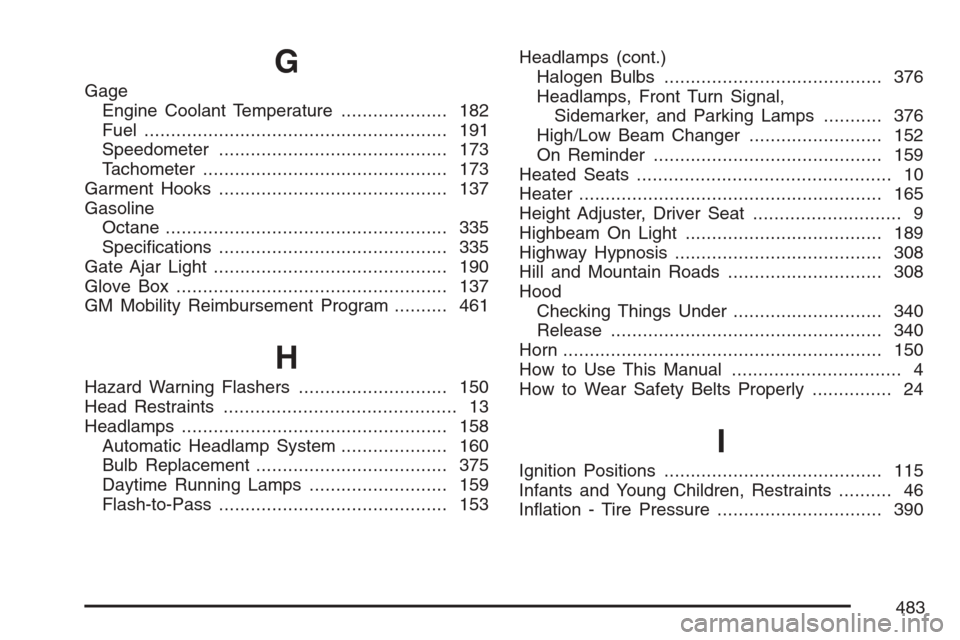
G
Gage
Engine Coolant Temperature.................... 182
Fuel......................................................... 191
Speedometer........................................... 173
Tachometer.............................................. 173
Garment Hooks........................................... 137
Gasoline
Octane..................................................... 335
Speci�cations........................................... 335
Gate Ajar Light............................................ 190
Glove Box................................................... 137
GM Mobility Reimbursement Program.......... 461
H
Hazard Warning Flashers............................ 150
Head Restraints............................................ 13
Headlamps.................................................. 158
Automatic Headlamp System.................... 160
Bulb Replacement.................................... 375
Daytime Running Lamps.......................... 159
Flash-to-Pass........................................... 153Headlamps (cont.)
Halogen Bulbs......................................... 376
Headlamps, Front Turn Signal,
Sidemarker, and Parking Lamps........... 376
High/Low Beam Changer......................... 152
On Reminder........................................... 159
Heated Seats................................................ 10
Heater......................................................... 165
Height Adjuster, Driver Seat............................ 9
Highbeam On Light..................................... 189
Highway Hypnosis....................................... 308
Hill and Mountain Roads............................. 308
Hood
Checking Things Under............................ 340
Release................................................... 340
Horn............................................................ 150
How to Use This Manual ................................ 4
How to Wear Safety Belts Properly............... 24
I
Ignition Positions......................................... 115
Infants and Young Children, Restraints .......... 46
In�ation - Tire Pressure............................... 390
483